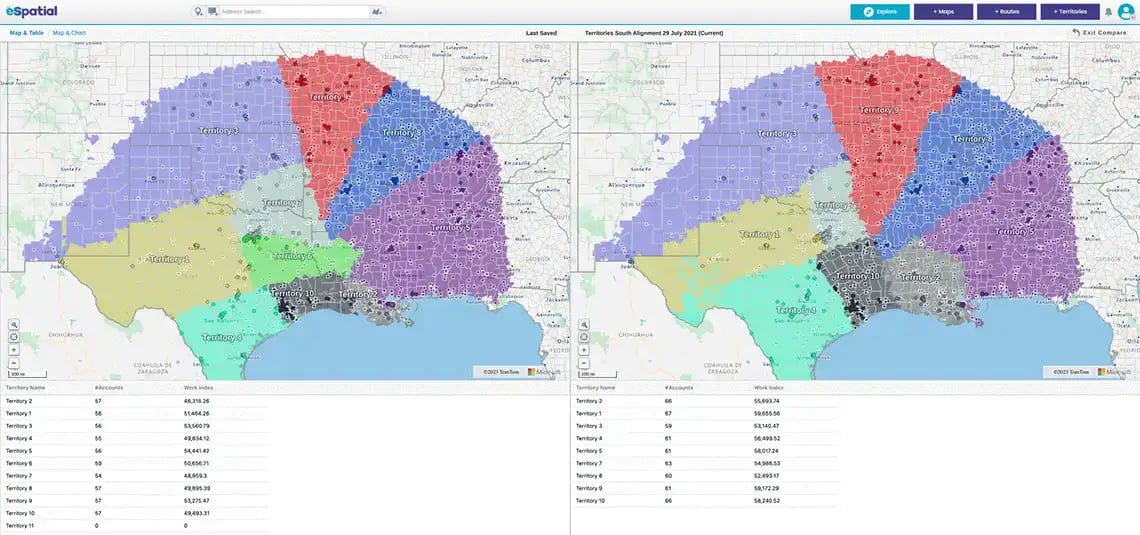Quick answer
Sales territory optimization isn't just about drawing lines on a map. It’s about aligning resources with revenue. Imbalanced territories kill morale and miss targets. Optimization ensures every rep has a fair shot at quota, maximizing selling time and minimizing travel costs.
The impact
- Maximize revenue: Align sales talent with the highest-value opportunities
- Balance workloads: Prevent burnout (and boredom) by distributing accounts fairly based on effort, not just geography
- Drive efficiency: Cut windshield time to increase face time with customers
- Adapt fast: Use software to adjust territories dynamically as market conditions shift
Why Territory Optimization Matters
Maximizing revenue with limited resources is a constant battle.
The solution: Don't just manage territories—optimize them. With the right mapping software, you turn complex logistics into a clear competitive advantage.
What you gain
- Efficiency: Eliminate wasted travel and overlap
- Insight: Make data-backed decisions instantly
- Alignment: Match resources directly to market opportunity
7 Steps to Build Optimized Sales Territories
Optimizing your sales territories is easier than you think, especially with support from the right tools. Here’s how to do it.
Step 1
Set Clear Goals
You can't optimize what you haven't defined. Start by identifying the specific business problem you need to solve.
Why it matters: Establishing objectives early creates a measurable framework for success. It ensures your design aligns with company priorities and secures stakeholder buy-in from day one.
Pick your target
Are you solving for:
- Revenue: Maximizing sales potential?
- Coverage: Reaching more customers?
- Efficiency: Slashing travel time?

Step 2
Balance With Workload Indexes
Territory balance isn't just about account count; it's about effort. A workload index factors in account size and travel time to prevent burnout and ensure fairness.

The impact
- Prevent burnout: Protect reps in high-demand zones from being overwhelmed
- Boost coverage: Ensure underperforming regions get adequate attention
- Drive productivity: Fairer distribution means higher output across the board
The winning formula: For maximum efficiency, combine territory optimization with route optimization. When advanced mapping, territory design, and routing work seamlessly together, your operations run on autopilot.
Step 3
Analyze Future Potential
Historical data is a rearview mirror. To drive growth, you need to look through the windshield. Relying solely on past performance hides missed opportunities. What worked yesterday won't necessarily work tomorrow.
The fix
Pivot to predictive analytics to assess:
- Untapped potential: Spot growth in overlooked regions
- Emerging trends: Identify up-and-coming industries before competitors do
- Future segments: Target customers poised to spend now
Step 4
Visualize Your Data
Data visualization tools—like heat maps and pin maps—transform complex datasets into intuitive dashboards. This makes trends, gaps, and opportunities impossible to miss.
The impact
- Decide faster: Make informed territory adjustments in seconds, not hours
- See the gaps: Spot coverage holes and revenue hotspots at a glance
- Align stakeholders: Visuals explain the "why" behind your decisions better than any spreadsheet, securing buy-in instantly

Step 5
Leverage Technology
Manual territory planning is slow, prone to bias, and outdated.
The solution: Automate the process. Advanced sales territory management tools optimize boundaries using real-time data to ensure fairness and efficiency instantly.
The eSpatial edge: Use territory management software like eSpatial to remove the guesswork. Our sophisticated algorithms slash administrative work and deliver balanced, precise results in minutes.
Step 6
Minimize Disruption
Territory changes are risky. Poor execution can sever customer relationships and tank team morale, undoing your sales territory optimization gains.
How to manage change
- Go slow: Implement adjustments gradually to minimize shock to the system
- Communicate clearly: Be transparent with sales teams about the "why" and "how" before changes go live.
- Maintain stability: Stop the constant shuffle. Avoid frequent overhauls to keep the team focused on selling, not relearning boundaries
Step 7
Measure and Iterate
Optimization isn't a one-time event—it's a continuous cycle.
Why it matters: Markets shift. Your territories must adapt to stay aligned with business goals.
What to track
- Revenue growth: Are targets being hit?
- Rep productivity: Is selling time increasing?
- Customer satisfaction: Is service quality consistent?
The feedback loop: Don't rely on data alone. Gather qualitative feedback from the sales team to identify pain points and opportunities for improvement early.
What's next: Ready to expand?
Learn more about how to grow a territory.
Advanced Territory Optimization Tactics
Benefit 1
Build Hierarchies:
- Structure for scale: eSpatial supports up to six hierarchy levels. Build from the territory up to ensure every manager has a balanced span of control
- Delegate fairly: Easily visualize who reports to whom to keep workloads even and granularly assess regional performance

It is an essential tool for managing delegation, for example, ensuring that each sales manager is responsible for 10 sales reps or each regional manager is responsible for eight sales managers. You have complete control over the sales structure, making it easy to ensure balance and fairness.
Benefit 2
Boost Collaboration:
- Get buy-in: Share interactive maps with reps before you finalize changes. Field feedback spots reality gaps that data misses
- Speed up: Real-time sharing accelerates the design process and gives HR the instant data they need for quota adjustments

Benefit 3
Drive Analytics:
- Track the truth: Use automated dashboards to monitor sales trends, customer behavior, and productivity
- Decide with data: Turn raw metrics into actionable insights to fix weaknesses and double down on strengths immediately
Use advanced mapping and analytics software to get the most out of your reports.
Benefit 4
Model Scenarios:
- Test before you fly: Don't guess. Simulate strategy shifts—like resource allocation or new market entries—to forecast outcomes
- Mitigate risk: Assess potential rewards and pitfalls before implementation to ensure your strategy holds water

View the pricing plans for eSpatial.
Conclusion: A New Revenue Engine Awaits
Transform your sales performance with a smarter, data-driven territory strategy. Use a sophisticated territory mapping tool to boost sales productivity, reduce territory design and re-alignment time, and transform the way your team collaborates.


